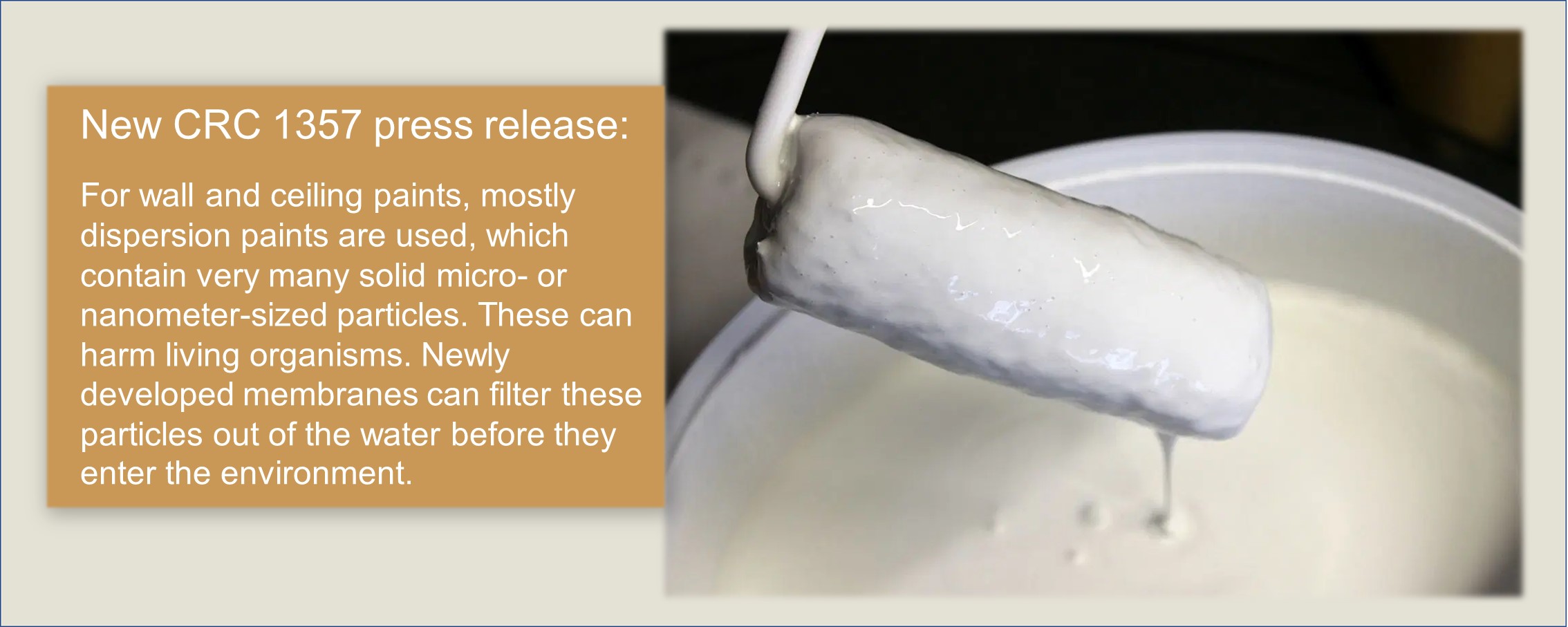News
New CRC 1357 press release: Particles from everyday wall paints can harm living organisms – novel membrane shows high filtering effects
27.08.2022

We are pleased to announce a press release from the University of Bayreuth on the study below:
You can find the UBT press release here: https://www.uni-bayreuth.de/press-releases/dispersion-paints
Particles from everyday wall paints can harm living organisms –novel membrane shows high filtering effects
Dispersion paints are mostly used in households for painting walls and ceilings. An interdisciplinary research team from the University of Bayreuth has now analysed the chemical composition of two typical dispersion paints and discovered a large number of solid particles in them which are only a few micro- or nanometers in size. Studies on biological test systems showed that these particles can harm living organisms. Using a novel membrane developed at the University of Bayreuth, these particles can be filtered out of water before they enter the environment.
The authors of the study are: Ann-Kathrin Müller, Julian Brehm, Matthias Völkl, Valérie Jérôme, Christian Laforsch, Ruth Freitag, Andreas Greiner.
"Disentangling biological effects of primary nanoplastics from dispersion paints’ additional compounds"
DOI: https://doi.org/https://doi.org/10.1016/j.apsoil.2022.104714
published in: Ecotoxicology and Environmental Safety
Abstract: Microplastic particles (MP) and nanoplastic particles (NP) as persistent anthropogenic pollutants may impact environmental and human health. A relevant potential source of primary MP and NP is water-based dispersion paint which are commonly used in any household. Given the worldwide high application volume of dispersion paint and their diverse material composition MP and NP may enter the environment with unforeseeable consequences. In order to understand the relevance of these MP and NP from paint dispersion we investigated the components of two representative wall paints and analyzed their composition in detail. The different paint components were then investigated for their impact on the model organism Daphnia magna and on a murine cell line. Plastic NP, dissolved polymers, titanium dioxide NPs, and calcium carbonate MPs demonstrated adverse effects in both biological test systems, indicating detrimental consequences of several typical components of wall paints upon release into the environment. The outcome of this study may form the basis for the evaluation of impact on other organisms, environmental transport and impact, other related technical materials and for the development of strategies for the prevention of potential detrimental effects on organisms.
and
Ann-Kathrin Müller, Zhi-Kang Xu, Andreas Greiner.
"Filtration of Paint-Contaminated Water by Electrospun Membranes"
DOI: https://doi.org/10.1002/mame.202200238
published in: Macromolecular Materials and Engineering
Abstract: Micro- and nanosized plastics as persistent anthropogenic pollutants have attracted more and more attention in recent years. A source of nanoparticles is, for example, water-borne dispersion paint, which consists of a variety of different materials with potential adverse effects on living systems. Therefore, a rising challenge becomes apparent to investigate remediation strategies for environmental media. This problem is addressed by utilizing electrospun membranes for filtration applications because of their outstanding properties, such as their high surface-to-volume ratio and ease of functionalization. The electrospun membranes are able to successfully filter different paint components, such as titanium dioxide and polyacrylate nanoparticles, as well as dispersed polymers and calcium carbonate microparticles. Besides the known size-exclusion mechanism, the membranes featured extraordinary properties, such as effective separation of components smaller than the pore size of the electrospun membranes. This property occurs due to the fiber surface functionalization and enables not only filtration of nanosized or dissolved mater at high filtration efficiencies up to 100% but also at a very low operating pressure. This combination of filter material properties cannot be achieved by conventional nanofiltration membranes and thus, demonstrates the high potential of electrospun membranes for the application in filtration for future environmental pollutants.

